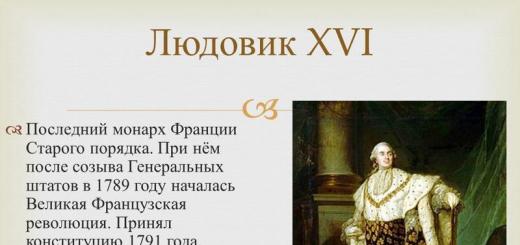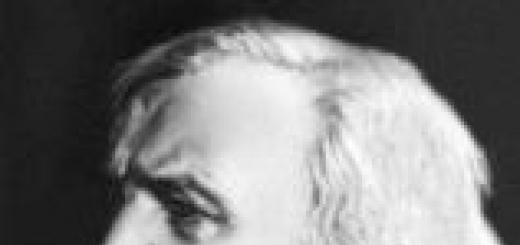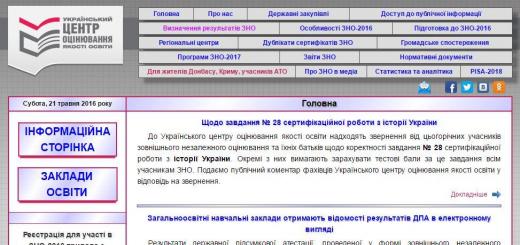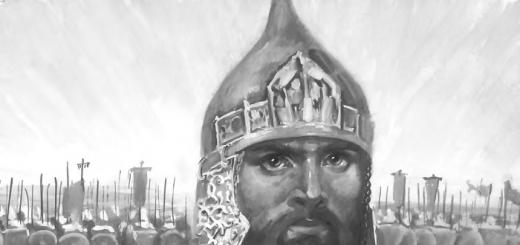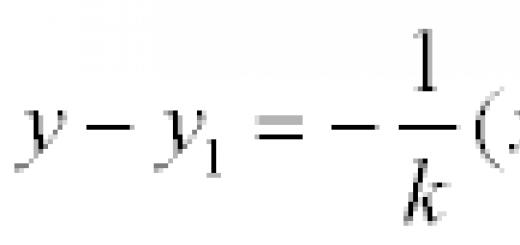The French Revolution
The French Revolution is the events that took place in France in the second half of the 18th century. As a result of revolutionary actions, the political system of the country was completely transformed. If earlier France was an absolute monarchy, then after the Great French Revolution a republic was proclaimed.
The motto that was in effect throughout the Revolution was:
"Freedom equality Brotherhood".
Causes of the Revolution
The main reasons for the Great Revolution include:
The ineffectiveness of the three trade-offs policy. (peasantry, bourgeoisie and privileged society)
France's development lags behind other developed countries (England).
People's dissatisfaction with the old established order.
The main forces of the revolutionaries.
Historians say that the French Revolution was made by the bourgeoisie. Marxists believe that during the revolution France moved from a feudal society to a capitalist one. Non-Marxists share the view that the revolution was anti-capitalist in nature.
The beginning of revolutionary actions in France
Historians consider the events of 1789 to be the beginning of the revolution in France. On July 14, the Bastille was taken.
Pre-revolutionary stop
During the meeting of the Estates General in May 1789, the peasant class demanded more freedoms. Increasing disagreements provoked mass uprisings. They took place in almost all major cities of France. The peasants were tired of hunger, drought and misery.
Trip to Versailles
The seizure of the Bastille by the people of France forced the king to recognize the action of the Constituent Assembly. However, the revolutionary wave has already spread to several cities. The uprisings intensified with each harvest.
The tense situation forced the king to cancel class privileges and sign the Declaration of the Rights of Man and Citizen. This document proclaimed the equality of all citizens before the laws of France.
Military campaign to Versailles. The Parisians headed to the royal residence at Versailles. Louis 16 is forced to leave his residence and flee to Paris.
The Constituent Assembly carries out administrative and church reform, abolishes estates, and establishes a policy of economic liberalism
The National Convention in September 1792 proclaims the country a republic. The Jacobin dictatorship only confirmed the new established regime.
Results of the revolution
The main result of the Great French Revolution was the destruction of the old style of government and the establishment of a new, constitutional system.
The French bourgeois-democratic revolution dealt a decisive blow to the absolutist monarchy and cleared the way for nascent capitalism. The Great French Revolution is a natural result of a long crisis of the feudal-absolutist system, it is the actual result of the inevitable conflict between obsolete feudal relations and the new, capitalist mode of production.
The last monarch of France of the Old Order. Under him, after the convening of the Estates General in 1789, the Great French Revolution began. He adopted the constitution of 1791, abandoned absolutism and became a constitutional monarch, but on September 21, 1792 he was deposed, tried by the Convention and soon executed by guillotine. Louis XVI



Economic: 1. Feudal exactions and excessive taxes 2. Restrictions on the purchase and sale of land 3. Countless internal customs 4. Financial crisis of 1787 5. Crop failures and famine Spiritual: 1. Spread of the ideas of the Enlightenment. (Voltaire, Montesquieu, Diderot, Rousseau) 2. Example of the Revolutionary War in the United States Prerequisites: Jean - Jacques Rousseau



It was the convening of this assembly that served as the impetus for the revolution, during which first the big bourgeoisie came to power, and then the third estate, which plunged France into civil war and violence. The alarmed government decided to seize the initiative and on June 20 tried to expel the members of the National Assembly from the meeting room. Then the assembled delegates swore an oath not to disperse until a new constitution was put into effect. The first signs of revolution.



On July 14, 1789, the people stormed the Bastille, a state prison that symbolized the absolute power of the king. This day is considered to be the first day of the Great French Revolution. The Constituent Assembly, formed by deputies of the third estate and the part of the liberal nobility that joined them, adopted the Declaration of the Rights of Man and Citizen on August 26, 1789. The result of this stage is the establishment of a constitutional monarchy. Stage I (July 14, 1889 – August 10, 1792)



Reforms: abolition of feudal rights and duties, a new administrative division was introduced, church lands were nationalized




The military intervention that began in April 1792 forced the Legislative Assembly to cry out “The Fatherland is in danger,” which gave rise to a popular uprising, the creation of the Paris Commune and the overthrow of the thousand-year-old monarchy. This period of the revolution (August 10, 1793) is the second stage and is characterized by intense struggle between the Jacobins and Girondins. II stage (17922 June 1793)

The Jacobins are members of the radical left political movement that established their dictatorship in France in the years. Leaders (Danton, Robespierre, Marat) Girondins are a moderate republican group. Supporters of individual freedom are fans of Rousseau's democratic political theory. Royalists are supporters of the monarchical form of government, monarchists.







The Jacobins came to power, which turned into a revolutionary democratic dictatorship. III stage (June 2/July 28, 1794)


A conspiracy developed against the Jacobins at the Convention. July 27, 1794 Their leaders were arrested and executed the next day. The entire system of dictatorial rule was gradually dismantled Stage IV () Thermidorian coup


The Directory constantly maneuvered between its opponents, the Jacobins and royalists. Ultimately, she compromised herself so much that she was easily overthrown in a coup d'état on November 910, 1799, led by the Republican general Napoleon Bonaparte.

1. Formation of a new nation; 2. The principle of equality before the law won; 3. Destruction of absolutism; 4. Decline of trade and industry; 5. Development of agriculture; 6. Changing the political map of Europe; 7. The birth of conservatism, liberalism, socialism, communism. Results of the revolution:


1 slide

2 slide

3 slide

4 slide
May 5, 1789 - the king convened the Estates General, which had not met since 1614) in order to achieve a vote of new taxes. May 5, 1789 - the king convened the Estates General, which had not met since 1614) in order to achieve a vote of new taxes. June 17, 1789 - Deputies of the Third Estate proclaimed themselves the National Assembly. July 9, 1789 - Constituent Assembly. July 14 - storming of the Bastille I stage of the revolution (July 14, 1789 - Aug. 10, 1792) Powerful rise of the popular movement throughout the country. "Municipal revolutions" in cities: the overthrow of old authorities, the creation of new municipalities, the formation of a bourgeois militia. The rise of the socio-political movement (formation of revolutionary clubs, activation of the peasantry).

5 slide
1. Decrees of August 4-11, 1789: 1. Decrees of August 4-11, 1789: abolition of church tithes, “personal” feudal duties, seigneurial courts, but the peasants did not receive land. “Real” feudal duties were not abolished. 2. August 26, 1789 - “Declaration of the Rights of Man and Citizen.” 3. Elimination of class divisions. 4. Nationalization of church property, state control over the church. 5. Change of administrative division, introduction of a new , consisting of departments, districts, cantons and communes 6. Elimination of obstacles that hindered the development of industry and trade 7. Le Chapelier's anti-worker law, which prohibited strikes and workers' unions (1791).

6 slide
Summer 1791 - creation of the Constitution: Summer 1791 - creation of the Constitution: France remained a monarchy (the king had only the highest executive power). The highest legislative power was transferred to the unicameral Legislative Assembly, which was elected on the basis of limited suffrage. A supreme court independent of the executive and legislative powers was created. The Constitution enshrined national sovereignty by declaring the nation, that is, all citizens, to be the “sole source of authority.”

7 slide
June 20, 1791 - an unsuccessful attempt by members of the royal family to secretly leave Paris. June 20, 1791 - an unsuccessful attempt by members of the royal family to secretly leave Paris. This event, which went down in history as the Varenna crisis, led to a sharp aggravation of political contradictions in the country.

8 slide

Slide 9
September 21, 1792 - formation of the National Convention September 21, 1792 - formation of the National Convention September 22, 1792 - a republic was declared, a new calendar was introduced. In the new Assembly, power was contested by two republican groups - the Girondins and the Montagnards (Jacobins). The Jacobins won. January 21, 1793 - Louis XVI is put on trial and beheaded. May 31 - June 2, 1793 - uprising in Paris - the Jacobins came to power, the arrest and expulsion of the Girondins from the Convention.

10 slide
III stage of the revolution III stage of the revolution (June 2, 1793 -July 27, 1794) - Jacobin dictatorship

11 slide

12 slide
July 27, 1794 (9 Thermidor of the second year of the republic according to the revolutionary calendar) - coup d'etat - overthrow of the Jacobins July 27, 1794 (9 Thermidor of the second year of the republic according to the revolutionary calendar) - coup d'etat - overthrow of the Jacobins (laws on suspicious and maximum prices were repealed , the Revolutionary Tribunal was dissolved, etc.) Summer 1795 - new Constitution (preserved a republic in France, limited suffrage and separation of powers).

Slide 13

Slide 14
However, the constitution of 1795 was unable to establish stable state power in France; the Directory constantly maneuvered between its opponents - the Jacobins and royalists, alternately attracting one or the other to its side. Ultimately, she completely compromised herself. However, the constitution of 1795 was unable to establish stable state power in France; the Directory constantly maneuvered between its opponents - the Jacobins and royalists, alternately attracting one or the other to its side. Ultimately, she completely compromised herself.
16 slide
1. Destruction of the old order (overthrow of the monarchy, destruction of the feudal system). 1. Destruction of the old order (overthrow of the monarchy, destruction of the feudal system). 2. Establishment of bourgeois society and clearing the way for the further capitalist development of France (elimination of feudal class orders). 3. Concentration of political and economic power in the hands of the bourgeoisie. 4. The emergence of forms of bourgeois land ownership: peasant and large property of the former nobles and bourgeoisie. 5. Creating prerequisites for the industrial revolution. 6. Further formation of a single national market. The influence of the ideas of the French Revolution. Ideas about human liberation, freedom, equality of all people found a response on all continents; they developed and were introduced into European society over the course of 200 years.
History teacher History teacher at the Salakhov Laboratory gymnasium, Surgut Bobeyko T.S.
Causes and beginning of the Great
French
revolution
Find out the reasons for the revolution
Formulate the tasks of the revolution
Identify the layers of society
interested in revolution
Study the events leading up to the start of the revolution
What obstacles exist to the development of capitalism?
What conditions are necessary for its development?
What processes in the economy and society indicate the development of capitalism?
From the work of A. Rambo "History of the French Revolution"
The nobles enjoyed the rights of masters: whenever land passed from one owner to another, a special tax was paid. Then the master was paid a qualification - a constant annual rent. To this we must add the master's rent, which in some cases doubled the qualification; corvee labor, which took away 52 days a year from the farmer; tolls on bridges, roads, markets; landowner monopolies, obliging small owners to use grape presses, mills and ovens built by the master for a special fee; the master's right to have dovecotes, which sacrificed peasant crops to pigeons.
From a letter from D.I. Fonvizin to Count P.I. Panin about the situation in France
Taxes, frequent and heavy, serve only to enrich insatiable bosses; no one dares to say a word against this oppression.
France is entirely farmed out. It is impossible to travel a few steps from Paris without being stopped by customs when returning. Almost everything imported into the city is paid as much duty as the thing itself is worth.”
- High taxes
- Feudal duties
- Shop orders
- Domestic customs duties
- Monopolies on the production and sale of products
- Economic crisis
- Impoverishment of the masses
- General discontent
The contradiction between the development of capitalism and the obstacles on its way in the form of:
Socio-economic reasons for the revolution
Louis XV
“Royal power resides only in my person alone.
The entire social order in its entirety comes from me, the interests and rights of the nation are all here, in my hand.
From the diary of Louis XVI on the eve of the revolution in France:
20th – deer hunting at 9 o’clock in Butar, shot one.
22nd - nothing.
25th - nothing, deer hunting in St. Apolline.
30s – nothing.”
Marie Antoinette
“If there is no bread, let them eat cake!”
Louis XVI
From a letter from D.I. Fonvizin to Count P.I. Panin about the situation in France:
“The king has in his hands all the power to violate the laws. Every minister is a despot in his department.”
“Finances are in disarray; a courtyard drowned in pleasure and extravagance; great ferment among people of all conditions, who strive for something new, not knowing what to desire, what to hope for; Moreover, the extraordinary development of the love of freedom, which is growing from day to day since the American war, is a confluence of circumstances that can soon cause a movement, unless someone's firm hand takes the reins to control events ... "
Traveling through France in 1787, the Englishman Arthur Young wrote in his diary:
What does this indicate?
caricature?
“Your Majesty!
There is no more money in the treasury!”
Total state expenditures amounted to 629 million livres.
From year to year, the national debt of France grew, which by 1788 reached 4.5 billion livres. 1/10 of state income was spent on the maintenance of Versailles alone.
Political and ideological reasons for the revolution
Crisis of the absolute monarchy
Class system and class privileges
Advanced ideas of the enlighteners
Impact of the American Revolution
- So that the import of foreign goods is prohibited, with the exception of those that are raw materials and are not produced in France...
- So that all customs offices are moved to the borders, so that all fees for the transportation of goods are abolished...
- So that all privileges for the exclusive right of trade be destroyed...
- That no tax may be imposed without the consent of the nation.
- So that all ecclesiastical and noble estates are taxed at the same rate as the lands of the unprivileged...
Formulate the objectives of the revolution
From the order of the merchants of the city of Troyes
deputies of the States General
Elimination of feudal
orders:
- Absolutism
- Class system
- Feudal
- Feudal duties
- Domestic
- Shop orders
- Royal monopolies
- Church tithe
land tenure
customs duties
Approval of the new order:
Tasks of the Revolution
- Participation in government by the people
- Equality before the law
- Democratic freedoms
- Freedom of enterprise
- Protectionist policy
Determine the nature of the revolution
and social strata interested in the revolution.
Participants of the revolution
deputies of the Third Estate proclaimed themselves representatives of the entire nation - the National Assembly
This is how the “awakening of the third estate” was portrayed
those. The assembly assumed the responsibility and right to establish the Constitution of the country.
Oath in the ballroom
A brilliant orator, deputy of the Estates General from the Third Estate, Count Mirabeau expressed an opinion that was shared by Parisian newspapers: “This great revolution will happen without atrocities and tears.”
However, troops were gathered in Paris and Versailles to disperse the Constituent Assembly.
"The enemy has prepared an attack,
He surrounded Paris with a ring.
Fright, embarrassment and excitement
Suddenly they stood up in a circle.
But the fear now recedes,
And everyone is full of a different passion.
You, Freedom! are calling.
And now Paris is saved by you..."
Storming of the Bastille
On July 14, 1789, the rebels of Paris stormed the Bastille fortress, freed the prisoners and tore to pieces the commandant of the fortress.
When Louis XVI was informed of the storming of the Bastille, he exclaimed:
“But this is a riot!”
To which they objected:
“No, sir, this is a revolution!”
Why the storming of the Bastille
was the start of a revolution?
"...Bastille! Your pride
Unable to resist us.
And if you enter into battle, then now
You will lie on your face.
The people of guns are not afraid of thunder.
He beats at your gates.
He is not afraid of the eight towers
And the thickness of these gray walls...”
The revolution spread throughout the country.
Elected authorities - municipalities - were formed in cities, and an armed force was created - the National Guard.
Gilbert de Lafayette
A new banner of France was approved: the white color of the Bourbons was added to the red and blue colors of the 3rd Estate.
The king was forced to recognize the legality of the existence of the Constituent Assembly.
Absolutism has been overthrown
the monarchy actually became constitutional.
Victory Banner
The Constituent Assembly adopted a decree abolishing seigneurial privileges.
The document began with the words:
"The Constituent Assembly completely abolishes the feudal order."
The peasants concluded that they were lords
don't owe anything...
"Night of Miracles"
- People are born and remain free and equal in rights. Social differences can only be based on common benefit.
- The purpose of any political union is to ensure natural and inalienable human rights. These are freedom, property, security and resistance to oppression.
"Declaration of the Rights of Man and Citizen"
- The source of sovereign power is the nation. No institution, no person can have power that does not clearly emanate from the nation.
- Freedom consists of the ability to do anything that does not harm another.
- The law has the right to prohibit only actions harmful to society. Everything that is not prohibited by law is permitted.
- Law is the expression of the general will. All citizens have the right to participate personally or through their representatives in its creation.
What similarities do you see?
with the Declaration of Independence?
Choose the correct statements
- The nobility was the first, privileged class in France.
- The French Revolution began on May 5, 1789.
- The Constituent Assembly was created to adopt the Constitution.
- The Bastille was a symbol of royal tyranny.
- The Declaration of the Rights of Man and the Citizen was adopted on August 26, 1789.
- The adoption of the Constitution by the Constituent Assembly was called the “Night of Miracles.”
- The main slogan of the French Revolution: “Liberty, equality, fraternity!”
Causes of the revolution
Political
Economic
Homework:
compare reasons
bourgeois revolutions
option 1: Netherlands and France
option 2: England and France option 3: America and France
Used materials
http://vive-liberta.narod.ru/journal/revol_songs.htm- site dedicated to the French Revolution
http://portfolio.1september.ru/work.php?id=575491– Kuyuzhuklu V., Myasnikov I. The Great French Revolution
Yudovskaya A.Ya., Baranov P.A., Vanyushkina L.M. General history. History of modern times, 1500-1800. 7th grade. - M., Education, 2009
- Timotysh A.N. The French Revolution. Causes. Start.
http://www.it-n.ru/communities.aspx?cat_no=2715&lib_no=21203&tmpl=lib&page=3- Zemlyanenko N.V. "The French Revolution
http://www.agitclub.ru/museum/revolution1/1789/rambofoto/third1.jpg- caricature of classes
http://img0.liveinternet.ru/images/attach/c/0/30/368/30368684_lyudovik_16_XVI.jpg-Louis XVI
http://i067.radikal.ru/0910/b5/3eeba5be51dd.jpg- Marie Antoinette
http://kolizej.at.ua/_pu/2/51025376.png- royal coat of arms of France
http://knowhistory.ru/uploads/posts/2010-09/1284040763_ludovik-xv.jpg- Louis XV
http://i034.radikal.ru/0801/31/5fa819c3ea52.jpg- sans-culottes
http://andmeronov.narod.ru/images/oflogotip.png- French revolution
http://ru.wikipedia.org/wiki/File:Sans-culotte.jpg-sansculotte
http://www.ukrmap.kiev.ua/program2010/wh9/vsesvit_history_9_files/image007.gif- Estates General
http://www.agitclub.ru/museum/revolution1/1789/declarat/declaration2.jpg- Declaration of the Rights of Man and Citizen
http://ru.wikipedia.org/wiki/File:Prise_de_la_Bastille.jpg-taking of the Bastille
http://www.ukrmap.kiev.ua/program2010/wh9/vsesvit_history_9_files/image009.jpg- oath in the ballroom
http://www.ukrmap.kiev.ua/program2010/wh9/vsesvit_history_9_files/image015.jpg-Mirabeau
http://1.bp.blogspot.com/_vYPIDwOMhm4/SttwusIV8DI/AAAAAAAAb-Q/JDUgE_D-_UA/s400/09-10-035.jpg- Camille Desmoulins
http://tourismeu.ru/uploads/posts/2011-02/1296859942_56.jpg- flag of the French Republic
http://www.agitclub.ru/museum/revolution1/1789/rambofoto/third2.gif- awakening of the third estate
http://ru.wikipedia.org/wiki/File:Gilbert_du_Motier_Marquis_de_Lafayette.jpg– Gilbert de Lafayette
To use presentation previews, create a Google account and log in to it: https://accounts.google.com
Slide captions:
" The French Revolution. From monarchy to republic" 8th grade Compiled by: Chumakova S.L. Teacher of history and social studies MKOU "Uzinskaya secondary school"
"Liberty, equality and fraternity." A trip to Versailles. Flight of the King. French Constitution of 1791. Overthrow of the monarchy. Proclamation of the Republic. Execution of the king. Establishment of the Jacobin dictatorship. Lesson plan.
Declaration of Human Rights... The most important document of the Great French Revolution, defining individual human rights. The Declaration was adopted by the National Constituent Assembly on August 26, 1789. The Declaration of the Rights of Man and the Citizen is based on the concept of equality and freedom that belongs to everyone from birth.
Declaration of the Rights of Man and Citizen The source of power is the people Abolition of feudal and class privileges The human right to life, freedom, etc. Private property is “inviolable and sacred”
In the Constituent Assembly, deputies were divided in their views. Declaration of the Rights of Man and Citizen Supporters of moderation and order sat on the right - they began to be called rightists. Supporters of change sat on the left - leftists
March on Versailles - October 5-6, 1789 Bread! To Versailles! Long live the king! On the morning of October 5, crowds of women who had stood in vain all night at the bread shops surrounded the town hall. Around noon, a crowd of 6-7 thousand women moved to Versailles. The king returned to Paris, but hunger was getting worse.
Flight of the King. Many nobles fled abroad in the hope that the king would join them. On June 20, 1791, Louis XVI and his family wanted to cross the border using forged documents, but were caught in the town of Varennes. He was accused of betraying the revolution. Louis XVI.
On September 3, 1791, the National Assembly proclaimed the first constitution in French history. It proposed to convene a Legislative Assembly - a unicameral parliament based on a high property qualification. A limited monarchy was established in the country. French Constitution of 1791 What did the Constitution of 1791 proclaim? ?
The Constitution proclaimed: Ensuring natural and civil rights Suffrage was introduced, limited by a property qualification Men who had reached the age of 25 and paid taxes received the right to vote All internal customs and the guild system were abolished The department became an administrative territorial unit (83) French Constitution of 1791
5) church lands were declared a national treasure and put on sale 6) a law was passed prohibiting strikes. The French Constitution of 1791. At this point, the Constituent Assembly ended its activities, which had so greatly changed the country.
On October 1, 1791, the Legislative Assembly began to work. It was led by a group of determined deputies from the Gironde department (they began to be called Girondins) French Constitution of 1791.
The Jacobins are members of the political club of the era of the French Revolution, who established their dictatorship in 1793 - 1794. They were formed in June 1789. They got their name from the club located in the Dominican monastery of St. James. Jacobin Political Club. Maximilian Robespierre Jean Paul Marat
The beginning of revolutionary wars. A revolutionary war begins between France and Europe. And Louis XVI began it, hoping to regain his former power.
The beginning of the revolutionary wars On April 20, 1972, the Legislative Assembly declared war on Austria.
But failures awaited the French at the fronts. Austrian and Prussian troops invaded France and occupied a number of fortresses. England also joined the enemies of France. "The Fatherland is in danger!" Dissatisfaction with the indecisive actions of the royal authorities grew among Parisians. In July 1792, the Legislative Assembly addressed the people with the appeal “The Fatherland is in danger!” Thousands of volunteers signed up for the army
Overthrow of the monarchy. Arrest of Louis XVI.
Capture of the Tuileries. On August 10, 1792, about 20 thousand rebels surrounded the royal Tuileries Palace. The assault was short-lived, but bloody. A decision was made to abdicate the king and convene a National Convention.
The uprising of August 10, 1792 was an episode of the French Revolution during which King Louis XVI was overthrown and imprisoned. As a result of the uprising, the monarchy in France was virtually eliminated, and the Republican Girondist Party, led by Brissot, came to power. Overthrow of the monarchy.
On September 20, 1792, in the battle near the village of Valmy, French troops repulsed the attacks of the Prussian army and forced it to retreat. This victory was the beginning of the country's liberation from invaders. Organization of defense. Battle of Valmy
The destruction of the monarchy invalidated the Constitution of 1791. Therefore, a Convention was called, elected by universal male suffrage. Among its deputies there were more supporters of extreme, decisive actions. As a result, the Girondins became right-wing. Proclamation of the Republic
Proclamation of the Republic Results of the activities of the Convention In September 1792, a republic was proclaimed in France. Recognized the right of representation in the Convention of the French colonies
Composition of the Convention The right (Girondists) sat on the lower benches of the Convention Most of the deputies did not belong to either the right or the left (plain or swamp) The left (Jacobins) occupied the upper benches, they were called Montagnards
The Republic is in danger. The execution of the king caused unrest among European monarchs. In the spring of 1793, the Austrian army went on the offensive. France is failing. The people blame the Girondins for everything. In Paris, the situation is tense. Arrests of Girondins began. Power in France passed to the Jacobins and their leaders
Jacobin leaders Jean Paul Marat Maximilian Robespierre Georges Danton
Establishment of the Jacobin dictatorship. The highest legislative body remained the Convention, which concentrated legislative and executive powers in its hands. In June 1793, the Convention adopted a new Constitution, which proclaimed France a REPUBLIC. But people did not receive democratic freedoms; there was a state of emergency in the country.
Terror. Guillotine On September 17, 1793, the Convention adopted the law on “suspicious persons,” which ordered the arrest of all suspicious persons. Thus, revolutionary terror was established in the country.
Results France became a republic Victory of the Third Estate But the dictatorship of the Jacobins was a deviation from the legal norms proclaimed by the Declaration WHAT ARE THE RESULTS OF THE REVOLUTION?
